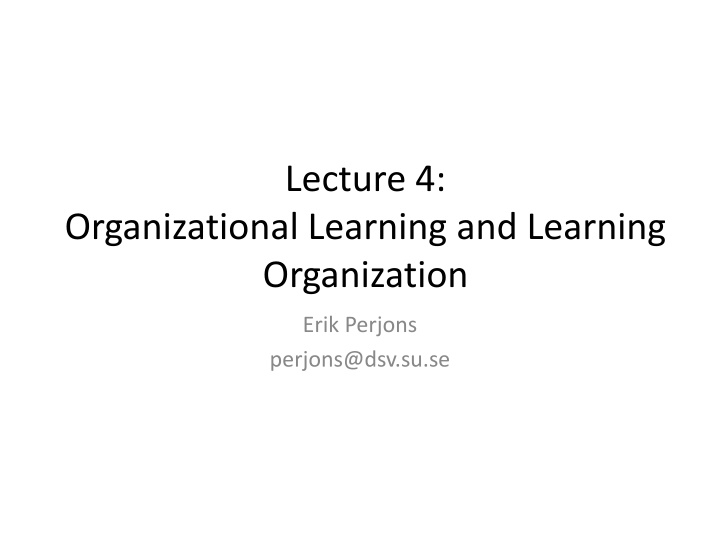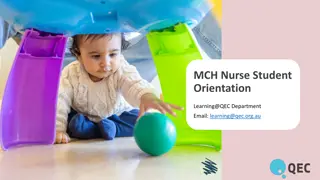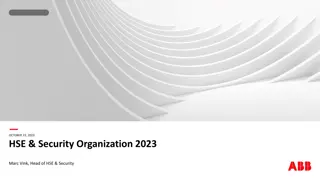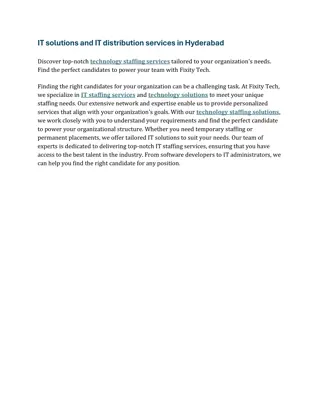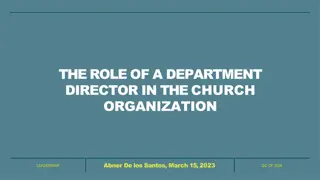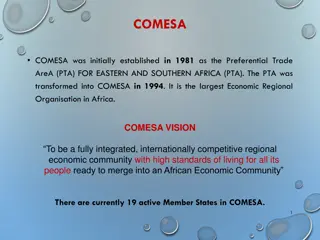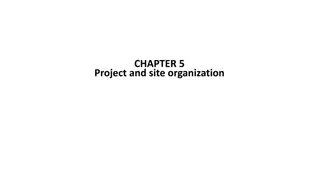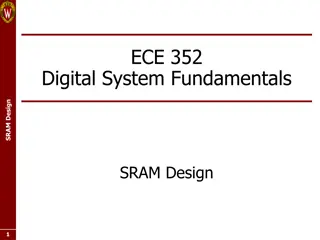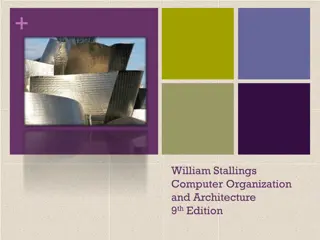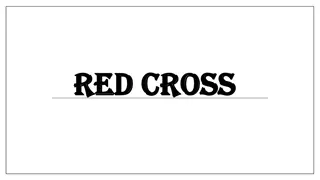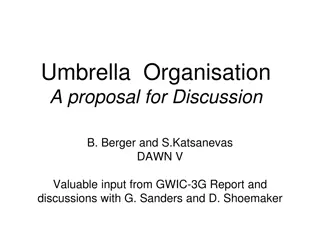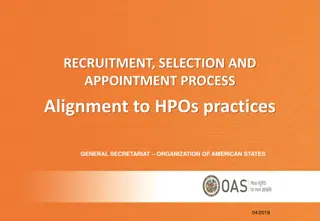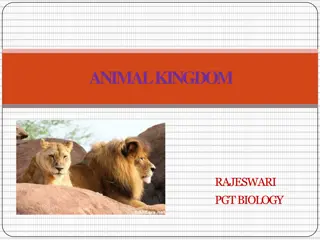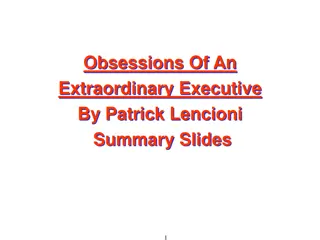Organization
In the realm of individual learning, two major views exist: the traditional transmission model and the modern constructive learning approach. The former emphasizes knowledge transfer from teacher to student, while the latter highlights learners' active construction of knowledge. Constructive learning practices involve collaborative activities, feedback loops, and promoting self-regulated learning. This model underscores the importance of learners taking control of their learning process and understanding how their learning works.
Download Presentation

Please find below an Image/Link to download the presentation.
The content on the website is provided AS IS for your information and personal use only. It may not be sold, licensed, or shared on other websites without obtaining consent from the author.If you encounter any issues during the download, it is possible that the publisher has removed the file from their server.
You are allowed to download the files provided on this website for personal or commercial use, subject to the condition that they are used lawfully. All files are the property of their respective owners.
The content on the website is provided AS IS for your information and personal use only. It may not be sold, licensed, or shared on other websites without obtaining consent from the author.
E N D
Presentation Transcript
Lecture 4: Organizational Learning and Learning Organization Erik Perjons perjons@dsv.su.se
Two major views of individual learning A traditional and teacher centric way of learning also called the transmission model A modern and more learner centric way of learning also called the constructive learning
Two major views on individual learning: The transmission model According to this traditional model, knowledge should be transfered from the teacher (i.e., the expert) to the learners (i.e., the students) The learners will memorising the knowledge that the teacher has presented. The learners are rather passive in this model
Two major views on individual learning: Constructive learning 1(2) According to constructive learning, which is a modern view on the learners, the learners should construct their knowledge themselves. The teacher s task is to create effective teaching and learning activities - called constructive learning practices - that support this way of learning. Example of constructive learning practices: the learners should work with the learning material (for example, books, papers, tools etc) by creating reports that present the constructed knowledge
Two major views on individual learning: Constructive learning 2(2) Example of constructive learning practices: Teachers and peers should provide feedback during the process Example of constructive learning practices: Learning occures when individuals engage in social activities around shared tasks and problems this is the base for social learning theory, but also see situated and experimental learning later in this presentation The learners need to understand how their learning process works that is, so called self-regulated learning should be promoted
Self-regulated learning 1(2) Self-regulated learning - is the process of taking control and evaluate your own learning and behavior Self-regulated learning - has proven to be very effective Self-regulated learning - is guided by: metacognition (that is, thinking about your own thinking), strategic action (that is, planning, monitoring, and evaluating your own learning activities as well as assessing your personal progress against a standard), motivation to learn
Self-regulated learning 2(2) Self-regulated learners - have knowledge of their academic strengths and weaknesses Self-regulated learners - have a repertoire of strategies they appropriately apply to tackle the day-to-day challenges of academic tasks Self-regulated learners - believe that successes or failures are attributes to factors within their control, for example, effort they spend on a task, effective use of strategies, etc. That is, they believe they can be successful by acting in a certain way
Feedback Feedback and feedback techniques are very useful for supporting constructive and self-regulated learning
Situated learning Situated learning is learning in a certain practice. That is, learning that take part in the same context as it is practiced A major idea in situated learning - is that knowledge is embedded in the practice. Knowledge is not isolated from practice See the case Patriotta: Knowledge-in-the-Making: The Construction of the Fiat s Melfi Factory presented in the end of this presentation Closely related to situated learning is experimental learning
Experimental learning Experimental learning is about learning from doing instead of reading about it Experimental learning is, more precisely, learning from the reflection on doing, and, as in ELM (see next slide), creating abstract concepts base on that reflection Experimental learning focuses on the learner and the individual learning process
Experimental Learning Model 1(4) Concrete Experience: Doing and thereby receiving a concrete experience Active Experimentation Planing a new concrete experience based on implication drawn from the previous step Reflective observation of the experience Abstract Conceptualizing: Create new abstract concept based on the result of the reflection from which new implication can be drawn
Experimental Learning Model 2(4) Experiential Learning Model (ELM) - represents a spiral of learning for individuals ELM - was developed by David Kolb and Ron Fry in the early 1970s. ELM - consist of four aspects of learning: concrete experience, observation of and reflection on that experience, formation of abstract concepts based upon the reflection, testing the new concepts According to Kolb and Fry, learning can begin with any one of the four elements, but typically it begins with a concrete experience
Experimental Learning Model 3(4) A faciltator/teacher can support the experimental learning process by asking questions, such as: What happend? Why did it happend? What did you learn? How can you use that? The learner can use ELM to understand his/her strength and weaknesses in the learning process
Experimental Learning Model 4(4) Criticizing ELM ELM does not include motivation to learn In reality reflection is often ignored there is seldom time given for that
Sensemaking Sensemaking - is the process of bridging a coginitve gap between an individual s mental model based on previous experiences and new observations that do not fit this model. Sensemaking - means that the gap is bridged by developing a changed and more refined mental model of the observed phenomena Sensemaking - is often needed in ambigous situations of high complexity and uncertainty
Situational awareness Sensemaking - is the process that leads to the outcome of situational awareness Situational awareness - is a state where individuals and organizations can understand the complex links between people, places, information, action and events - and how these things influence present and future goals - that is, the state allow individuals and organizations to make inferences of future scenarios and act accordingly
Team learning Definitions: Individual learning can be view as the increased capacity of an individual to take effective actions (Kim, 1993) Team learning - can be view as the increased capacity of the group to engage appropriately in dialog and discussion (Senge, 1990)
Dialog Dialog - is a free and creative exploration of complex issues Dialog - can be seen as a flock of birds taking flights individuals in the flock are permitted to take of in another direction and others are then following but everybody is in some way interconnected Dialog - involves active listening Dialog - includes that you observe your own thinking and go beyond your own understanding and assumption Dialog - means treating each participant equally Dialog - is useful for divergent thinking
Discussion Discussion - means that different views are presented and defended with arguments Discussion - often ends up in a conclusion and a course of action Discussion - is a complement to dialog Discussion - is useful for convergent thinking
Sensemaking again Sensemaking has similarities to dialog and sensemaking often make use of dialog
Three characteristic of effective team learning Bring together the collective intelligence of the team instead of insights of dominant individuals Provide innovative and coordinated actions, which implies alignments of minds among team members Ability to share practices and skills betweem teams
Argote Regarding team learning also check the chapter of Argote
Organizational learning Two different definitions for organizational learning: Organizational learning - is the area studying of how organizations learn based on their gained experiences (Vasenska, 2013). Organizational learning - is the process of improving actions through better knowledge and understanding (Fiol&Lyles, 1985) The area of organizational learning includes theories, models, methods and processes of organizational learning
Organizational learning The processes of organizational learning include: creating, organizing, retaining, sharing/transferring, and applying knowledge within an organizations (as well as between organizations). These processes can be seen as adaptive as the organization learn from experiences.
Organizational learning The knowledge in organizational learning could be anything that could improve an organization s behavior, such as: improve customer relations increase number of promising innovations make production more efficient, and produce higher quality products
Organizational learning The area of organizational learning is an important part of, or similar to, knowledge management - depending on the definitions of organizational learning and knowledge management respectively
Organizational learning Organization learning is one of the three levels of learning, which are all studied and compared in the area of organizational learning: Individual learning Team learning Organizational learning
Organizational learning The 4I model Crossan et al, 1999) specify for each of the three levels of learning, the processes and outcome, thereby providing an understanding how they differs from each other: Level Process Outcome Individual learning Intuiting Interpreting Experiences Cognitive maps Team learning Integrating Shared understanding Mutual adjustment Organizational learning Institutionalizing Routines Processes Rules
Organizational learning models Important models and theories in the area of organizational learning are: - SECI model - Single and double loop learning
SECI model The SECI model can be viewed as organizational learning in form of a continuous learning process tacit knowledge tacit knowledge knowledge explicit Socialisation Externalisation knowledge tacit Sharing experiences, Observing, Imitating, Modeliing, Creating metaphores and analogies, Writing it down Combination Internalisation knowledge explicit knowledge tacit Using codjfied knowledge for actions, Applying goal based training Sorting, Adding, Categorising, Using best practices explicit knowledge explicit knowledge
Single loop learning SINGLE LOOP LEARNING The most common style of learning: Solve a problem by using a strategy and/or method, and if not solved use a different strategy and/or method . The learning style improve the system as it exists it finds strategies and methods within the given system Strategies and Methods Result What we get? What we do?
Double loop learning Strategies and Techniques Result Assumptions Why we do what we do? What we get? What we do? DOUBLE LOOP LEARNING Learning by analyzing the underlying assumption, goals, policies, values and/or beliefs behind what we do. If these change, the stategies and/or methods used need to be aligned with the changed assumptions, goals, policies, values and/or beliefs or changes, that is, new stategies and/or methods will be used
Single and double loop learning SINGLE LOOP LEARNING Strategies and Methods Result Assumptions Why we do what we do? What we get? What we do? DOUBLE LOOP LEARNING
Single and double loop learning Chris Argyris coined the terms Single Loop Learning and Double Loop Learning . He claimed that these are two types of organizational learning The terms were related to George Bateson s concepts of first and second order learning.
Single loop learning Single loop learning is a learning that occurs when an organization solve problems by using strategies and/or methods within present assumptions, goals, policies, values and/or beliefs Single loop learning - is a form of exploitation behavior, that is, learning to perform the same process better or faster Single loop learning is an approach similar to the behaviour perspective of learning as the latter view learning as a change in response based on stimuli such as positive reinforcement
Double loop learning Double loop learning is a learning that occurs when an organization solve a problem by first changing the assumptions, goals, policies, values and/or beliefs before deciding which strategies and/or methods to apply. Double loop learning is a form of exploration behavior, that is, experimenting with new strategies and processes to work differently Double loop learning is an approach similar to the cognitive perspective of learning as the latter view learning as a mental process (including perception, reasoning, memory) and is focusing on understanding the different levels of experiences and meaning
Single and double loop learning An example: A firm s sales numbers are decreasing dramatically Single-loop learning: In this scenario, the sales force team is blamed. Therefore, measures were introduced to force the sales team to work harder. Double-loop learning: In this alternative scenario, the underlying assumptions are questioned - such as the quality of the products and services. For example, the customer may find the products and services outdated, unappealing and non valuable. Therefore, the firm may decide to invest resources on developing more innovative and appealing products and services
How to measure organizational learning There are many way to measure organizational learning, such as: Changes in organizational processes and practices that improve the behavior of the organization Number of innovations, patents etc ...
The learning organization A learning organization is an organization that support organizational learning and constantly adapt to its environment in order to be successful The term was coined by Peter Senge
Peter Senge Senge (1990) means that organizations should be like communities. The employees will, thereby, feel committed to the organization and work harder In The Fifth Discipline (1990), Senge stated that a learning organization has five main characteristics, presented in the following slides
The Fifth Discipline System thinking is the thinking where an organization is seen as system, where all its parts must be analyzed at once, as a whole. The focus is on the relationships between the parts and to identify, analyze and manage the problems of these relationships
The Fifth Discipline Personal mastery is the empowerment of the employees by introducing organizational learning in the organization. This require, according to Senge, a culture of learning since learning cannot be forced upon individuals. The employees need to be committed to learn
The Fifth Discipline Mental models are the models (in the head of the employees) that guide the actions of the employees. These models need, according to Senge, to be challenged in order to create an open organizational culture supporting organizational learning
The Fifth Discipline Shared vision is a long term goal that need to be developed to create a common identity and a culture motivating employees to learn. The employees own personal goals need to be aligned with this vision
The Fifth Discipline Team learning the organizations need to facilitate team learning, which require that the organizations create structures that support dialogues and discussions, and thereby an open communication and a shared understanding. Team learning improve problem solving capacities and learning practices in an organization
Critics againts the concept of the learning organisation It is difficult to find learning organizations in real life Learning initiatives, which is the focus of the learning organization, are not enough for transforming an organization, since the work practices and processes need to be changed as well There is too much focus on culture in Senges description. In order to transform an organization, the work practices and processes need to be considered as well [Finger & Brand, 1999]
The adaptive or agile organisation The concepts of learning organization is closely related to the concepts of adaptive and the agile organization An adaptive organization is an organization that is adapting its behavior when needed because of changes in the environment. Therefore, an adaptive organization needs to monitor and senses signals from its environment Similar, an agile organization is an organization that sense environmental changes and respond accordingly (Overby et al, 2006)
